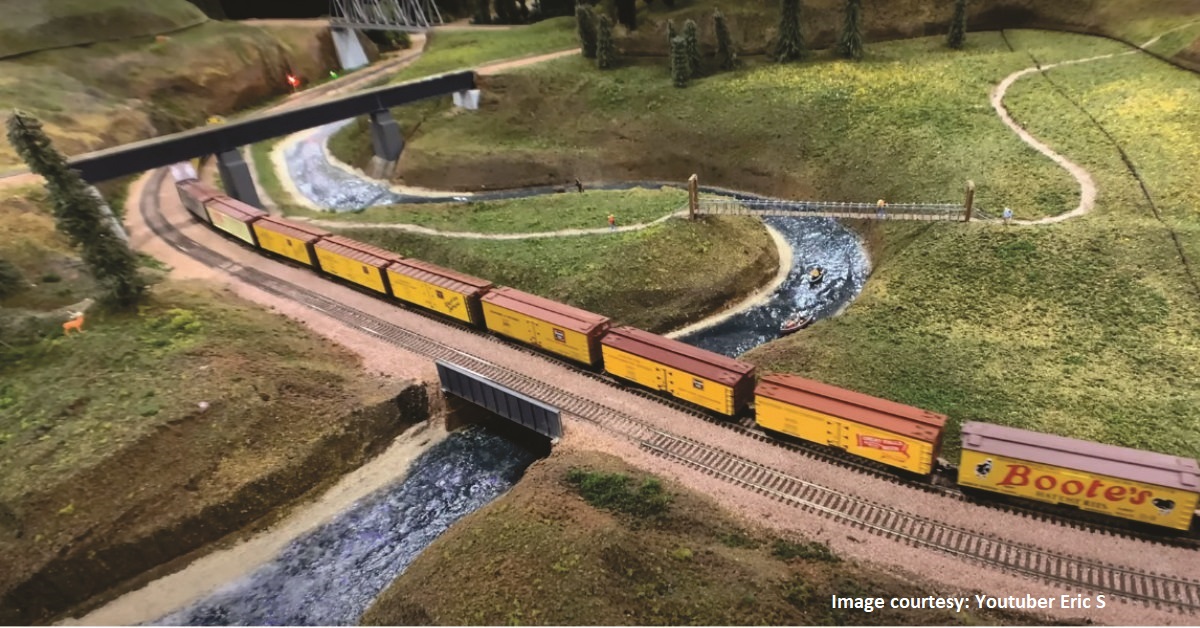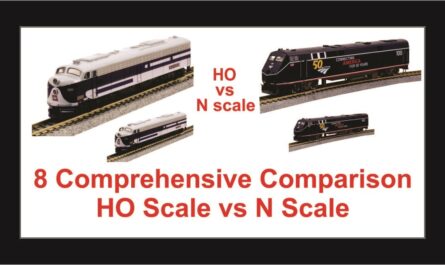Free-mo module represents a revolutionary approach to model railroading, emphasizing standardization, modularity of layouts and Understanding community collaboration. It Providing ‘Prototype modeling in a flexible and modular environment.’ In this in-depth explanation, we’ll see the origins, principles, advantages, disadvantages, and cost considerations associated with Free-mo module. Free-mo module runs single main line and it can be also connect point to point or point to loop or loop to loop or even in continues run over oval shape setups.
1. Free-mo Module Origin
Free-mo, derived from “free modular,” is a modular model railroad standard that deviates from traditional fixed layouts by promoting a free-form, modular design. Developed in the early 2000s. Initially it started in 1994 by Mr.Chris Palomarez and Mr. Art Armstrong at the San Luis Obispo Model Railroad Club (SLOMRC). Free-mo has gained popularity for its focus on standardization, realism, creativity, and collaboration within the model railroading community.
Basically Free-mo standard inspired by European ‘FREMO’ concept. Free-mo standards prime aim is to make layout in some standard dimensions, especially for laying tracks in such a modular way that one can extend it by connecting fellow modelers layout. Layouts two end should be as per standards so that it easily connectable to other free-mo module layouts.
2. Principles of Free-mo Module
1. Modularity: Free-mo layouts consist of individual modules, typically measuring around 2 feet wide and varying in length. These modules can be interconnected to form larger layouts, providing flexibility and adaptability.
2. Standards: Free-mo adheres to specific standards to ensure interoperability between modules. Standards cover track alignment, electrical connections, and scenery interfaces, allowing modelers to seamlessly combine their modules to create cohesive layouts.
3. Realism: One of the central tenets of Free-mo is the pursuit of realism. Modelers aim to replicate real-world railroads by focusing on accurate track arrangements, realistic scenery, and prototypical operations.
4. Narrow Gauge Focus: Free-moN (Free-mo Narrow) is a variant of Free-mo that specifically caters to narrow gauge railroads. Narrow gauge modeling involves tracks spaced closer together than standard gauge, providing a distinctive look and often associated with smaller, more specialized operations.
5. Flexibility: Free-mo layouts can be set up and taken down easily, making them suitable for temporary displays at model railroad shows or exhibitions. The flexibility allows for experimentation with different layouts and configurations.
6. Digital Command Control (DCC): Free-mo layouts often incorporate DCC technology, enabling independent control of multiple trains on the same track. DCC enhances the realism of operations by allowing precise control over locomotives and accessories. www.nmrabr.org.uk
3. Advantages of Free-mo Module:
1. Creativity and Customization: Free-mo provides modelers with a high degree of creative freedom. Each module is a canvas for individual expression, allowing modelers to design and build unique scenes and landscapes.
2. Realism and Prototypical Operations: The emphasis on realism in Free-mo Module extends to prototypical operations. Modelers simulate the activities of real railroads, including train schedules, switching operations, and other realistic scenarios.
3. Collaborative Community: Free-mo encourages collaboration within the model railroad community. Modelers often work together to create larger, more intricate layouts by combining their individual modules. This fosters a sense of community and shared passion for the hobby.
4. Flexibility in Layout Design: The modular nature of Free-mo allows for a wide range of layout designs. Modelers can experiment with different track arrangements, scenes, and themes, adapting their layouts to specific preferences and available space.
5. Ease of Transportation: Free-mo layouts are designed for easy transportation. Modelers can disassemble modules and transport them to different locations, making it convenient for participation in model railroad shows and events.
6. Scalability: Free-mo layouts are scalable, allowing modelers to start with a basic module and gradually expand their layouts over time. This scalability accommodates varying levels of commitment and resources.
4. Disadvantages of Free-mo Module:
1. Initial Setup Complexity: Setting up a Free-mo layout for the first time may pose a challenge, especially for those new to the system. Understanding and implementing the standards, track alignment, and electrical connections require careful attention to detail.
2. Cost Considerations: While Free-mo Module offer scalability, the initial investment in modules, track, scenery, and DCC equipment can add up. Modelers should consider their budget and long-term commitment to the hobby.
3. Learning Curve for DCC Technology: Incorporating DCC technology into Free-mo layouts may involve a learning curve for modelers unfamiliar with digital control systems. Understanding DCC programming and troubleshooting can require additional effort.
4. Dependency on Collaboration: While collaboration is a strength of Free-mo, it also means that the success of a layout depends on the cooperation of multiple modelers. Scheduling and coordinating collaborative efforts can be challenging.
5. Limited Spontaneity in Module Placement: The predefined alignment and connection requirements of Free-mo modules may limit the spontaneity of layout configurations. Modelers need to plan in advance to ensure seamless connections between modules.
5. Cost Considerations for Free-mo Module:
1. Module Construction: The cost of constructing Free-mo modules can vary based on factors such as materials used, scenery details, and module size. Modelers may spend anywhere from a few hundred to several thousand dollars on module construction, depending on complexity. Other expenses like Track and Scenery, Digital Command Control (DCC and Vehicles and Rolling Stock these expenses is common in all kind of Module whether free-mo or any other Module depending on model scale.
Free-mo Module represent a dynamic and engaging segment of the model railroad hobby, offering modelers the opportunity to create realistic, collaborative layouts with a focus on standardization, creativity and prototypical operations. While there are challenges such as initial setup complexity and cost considerations, the advantages of flexibility, realism, and community collaboration make Free-mo a compelling choice for modelers seeking a unique and immersive railroad modeling experience. As the hobby continues to evolve, Free-mo Module stand as a testament to the innovation and creativity within the model railroad community.



